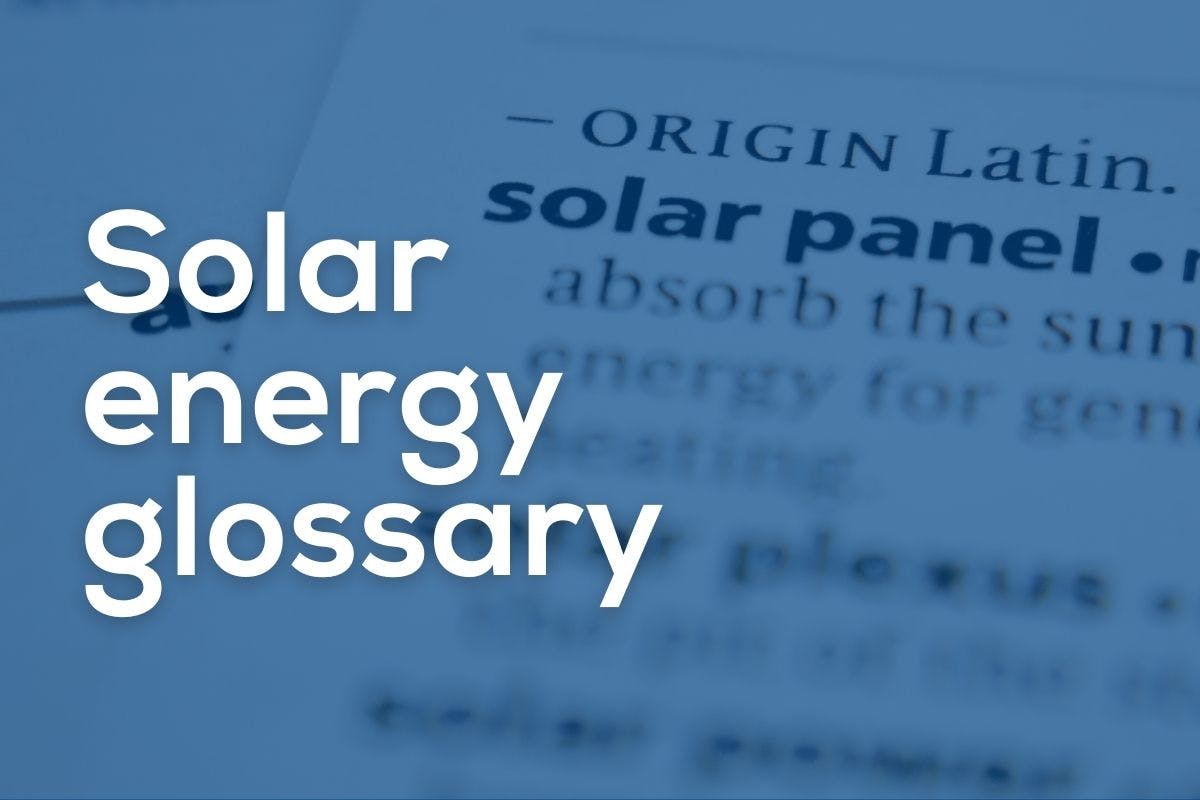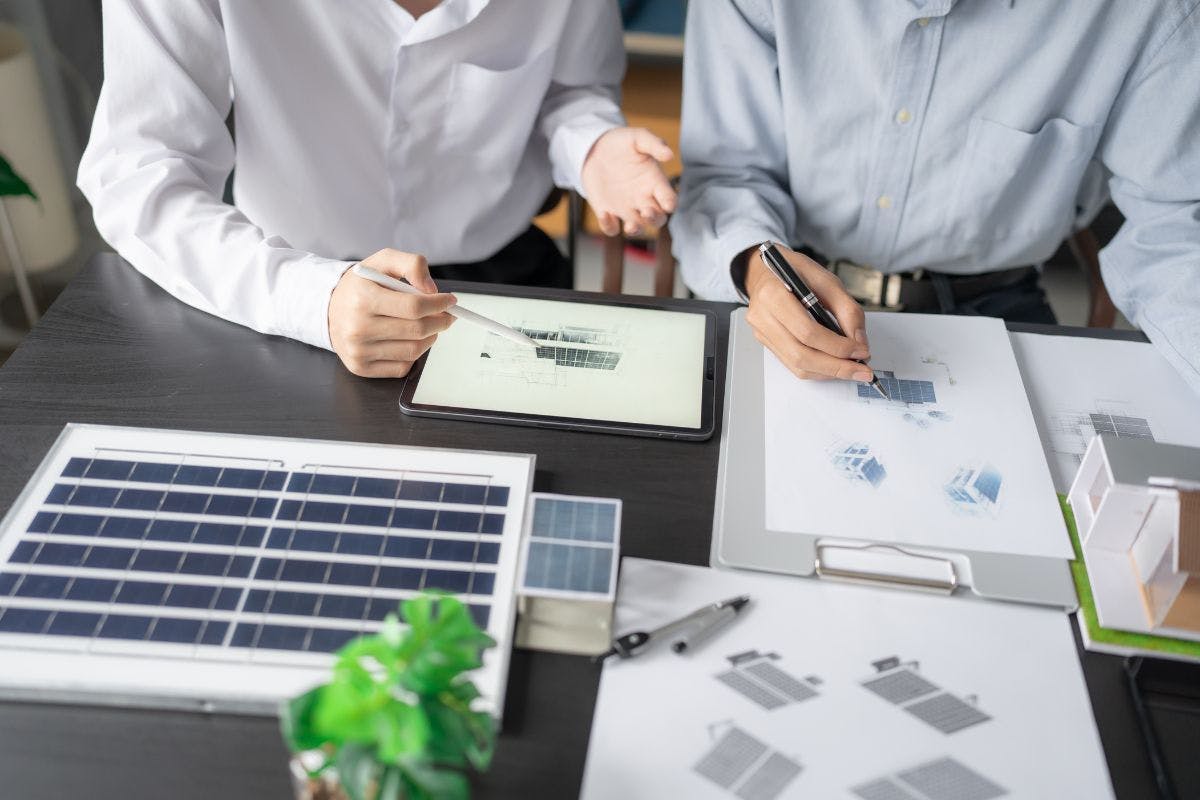Solar Glossary: Key Solar Terms Defined
Last edited

Author
Andrew Giermak
Solar and Electrification Writer and Editor

Editor
Andrew Blok
Electrification and Solar Writer and Editor

Like every industry, the world of solar has its own jargon and some of the terms and concepts can be complicated.
If you’re just starting out on a solar journey for your home, here’s the solar energy vocabulary you should know about home solar panels, how they work, and solar power’s benefits for a home, your budget, and the environment.
See how much you can save by going solar with Palmetto
Glossary | Solar Terms to Know
- Array: An array is the most common word used for a grouping of solar panels. You may find an array of solar panels on a rooftop, in an open field, or even floating on a body of water.
- Azimuth: A solar azimuth is the horizontal angle solar panels face in relation to the equator. In the US and all of the northern hemisphere, solar panels are generally tilted south, at the same latitude as your location relative to the equator.
- Bill credit: Bill credits reduce your electric bill thanks to solar power generation. When solar panels send excess electricity to the grid, bill credits appear as line items on monthly utility statements and may be labeled as “exports,” “power generated,” “energy produced,” or something similar.
- Circuit breaker: On your home’s main electric service panel, circuit breakers protect your system from fires or damage that would be caused by overcurrents. As an important safety measure, solar energy systems are also installed with circuit breakers and a ”DC disconnect switch” that can instantly turn solar panels off when necessary.
- Community solar: Community solar programs allow multiple individuals to benefit from a single solar energy installation. Popular among those who rent or cannot effectively host solar panels on their property, community solar members can virtually purchase renewable energy through several different financing and membership structures.
- Critter Guard: Much like how the brands Kleenex and Band-Aid have become synonymous with tissues and bandages, Critter Guard is a popular brand of protective material used in solar installations. Products like Critter Guard block access to the space beneath solar panels from critters like birds and squirrels, preventing damage and provide essential solar pest protection service.
- Grid-tied: A grid-tied solar energy system (also known as a grid-tie, on-grid, or utility-interactive) is connected to the utility grid. Most solar panels installed on homes in the US are grid-tied unless the property is located off the grid.
- Ground-mounted solar: Ground-mounted solar panels are installed on the ground, raised, and tilted at an angle to best capture sunlight. Technically speaking, carports and solar panels above parking lots can also be considered ground-mounted systems.
- Electric panel: An electric panel (also known as a service panel, distribution board, or breaker) is a metal box most likely located in your basement or garage. As the hub for your home’s electricity, both grid and solar-generated power travel through your electric panel.
- Energy audit: An energy audit is an assessment of your home's energy consumption and efficiency. When performed by a professional, an energy audit will provide a full analysis of how your home uses power, including opportunities to improve energy efficiency with lighting, appliances, insulation, or other solutions.
See what home electrification can do for you:
- Inflation Reduction Act (IRA): The Inflation Reduction Act of 2022 expanded access to renewable energy in the US in many ways. The IRA extended the investment tax credit (ITC), a credit of up to 30% of total solar project costs through 2032.
- Inverter: An inverter is a critical component of a home solar energy system. Used to convert new DC solar power into usable AC electricity, today’s home inverters usually come in two forms: a string inverter or microinverters.
- Investment Tax Credit (ITC): Extended by the Inflation Reduction Act, solar buyers can earn an investment tax credit (ITC) after purchasing a qualifying residential renewable energy system. Officially titled the Residential Clean Energy Credit, it’s one of the most influential incentive programs in the growth of dispersed solar energy.
- Kilowatt (kW): A kilowatt is a unit of energy equal to 1,000 watts. Most electrical equipment is rated in watts, including refrigerators, microwaves, and solar panels. Most solar energy systems are rated in kilowatts, the total wattage of all panels installed.
- Kilowatt-hour (kWh): A kilowatt-hour is a measurement of electricity usage, specifically one kilowatt of energy over one hour. Much like how your energy bill is calculated using kilowatt-hours, the amount of electricity produced by your solar panels is also measured in KWh.
- Microinverter: An alternative to a central string inverter, microinverters are used to convert the power generated by individual solar panels one at a time. Microinverters are typically located on the undersides of solar panels and have several pros and cons when compared to string inverters.
- Net billing: Like net energy metering, net billing (or a net billing tariff) is a utility agreement that credits homeowners for excess solar energy production, though not at the retail rate for electricity, like true net metering. In 2023, a net billing structure was introduced in California, which is commonly referred to as NEM 3.0.
- Net energy metering (NEM): Net energy metering is a utility billing mechanism that credits solar energy producers for electricity they send to the grid. Home solar net metering policies vary greatly by state and utility, but overall, NEM has been recognized as an important initiative in increasing solar capacity in the US.
- Offset: Solar offset refers, usually in a percentage, to the amount of electricity generated by a solar system compared to the overall electricity consumed in a home. This is an important figure in determining the money you’re saving.
- Operations and maintenance (O&M): Operations and maintenance for a solar system refers to diagnostics, monitoring, service, and maintenance needed over a system’s lifespan.
- Peak sun hours: Peak sun hours are a measurement of the strength of sunlight a specific area receives over time. A peak sun hour is 1,000 watts per square meter for an hour. If a location gets 1,000 watts of sunlight over an hour, that’s a peak sun hour. If that same location gets 500 watts of sunlight over two hours, that’s also a peak sun hour.
- Performance-based incentive (PBI): A performance-based incentive is a type of financial incentive earned for the production of a solar energy system. Typically offered by utilities and increasing in popularity with battery storage, PBIs are different from most other solar credits and incentives in which homeowners qualify upfront.
- Permission to operate (PTO): After a new system is installed, and after permitting is complete, you will receive permission to operate from your local utility company and the solar system will be activated.
- Solar battery: In a home energy system, a solar battery can be used to store electricity for later use, such as overnight or during a local electrical outage. Capable of increasing your utility savings and energy independence, solar battery storage has been becoming more and more popular in the 2020s largely thanks to lowered costs and incentives like the Residential Clean Energy Credit.
See how much you can save by going solar with Palmetto
- Off-grid: An off-grid solar energy system is completely independent of utility connection.
- Palmetto App: The Palmetto mobile app is your central hub for managing and understanding your solar energy system. Our app gives you real-time monitoring, easy access to your account, and information on clean energy and energy-efficient products.
- Photovoltaic (PV): Photovoltaic describes any technology capable of converting sunlight into electricity. Today most of the solar energy systems you see on roofs are photovoltaic and classified as either monocrystalline or polycrystalline (black vs blue solar panels).
- Solar lease: Like an apartment or car, leasing solar allows you to benefit from a renewable energy installation without owning the system and upfront expenses. You could start saving immediately through a solar lease or a power purchase agreement (PPA).
- Solar ownership: As the most popular method of home solar energy adoption in the US, solar ownership represents an outright equipment purchase through either cash or a loan. When you buy or finance solar panels to achieve solar ownership, you can increase the value of your home and lower your energy bills with several different payment options.
- Solar panel efficiency: Solar panel efficiency is how well solar panels convert sunlight into electricity. It is calculated as a percentage, generally about 20%, although more efficient residential panels are now about 22-24% efficient. In research settings, solar cells have reached more than 44% efficiency.
- Solar payback period: Your solar payback period is how long it takes for you to save as much on your electric bill as you paid for your solar panel system. A new system’s payback period can vary because of many factors, but is often from 6-10 years.
- Solar shingles: Solar shingles convert sunlight into electricity while maintaining the shape, size, and aesthetic of traditional roofing materials. Solar shingles are building integrated photovoltaics (BIPV).
- String inverter: Commonly used in solar energy systems, a string inverter is a piece of hardware that centralizes the direct current (DC) generated by one or several “strings” of multiple solar panels. The purpose of a string inverter is to convert solar power into alternating current (AC), the form of electricity used in homes and across the power grid.
- Time-of-use rates: Time of use (TOU) rates are a key part of demand-based energy pricing structures, in which the cost of electricity is tied to the time of day, week, and year it is consumed. Within a TOU rate structure, a typical day is divided into on-peak and off-peak hours, with higher and lower prices for electricity, respectively. TOU rate structures may also affect the value of solar bill credits, depending on when the energy was produced and sent to the grid.
- Virtual power plant (VPP): Participants can join a virtual power plant and their energy devices, such as batteries and smart thermostats, can be used by a VPP operator to balance supply and demand on the electric grid. Customers are paid for the energy they send to the grid.
See what solar can do for you:
Have More Questions About Solar Energy?
Explore all of our solar energy resources, our solar savings calculator, or contact Palmetto today. No matter where you are on your solar journey, Palmetto is here to help!


